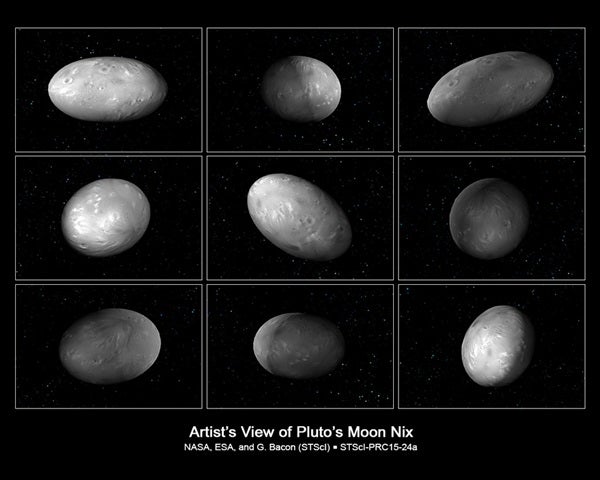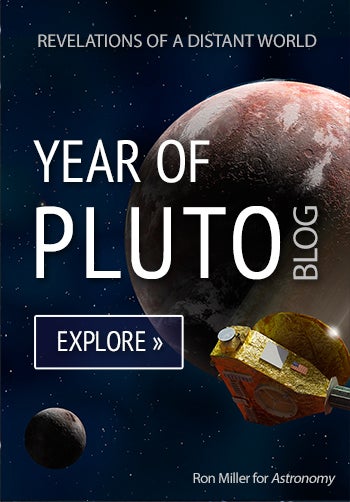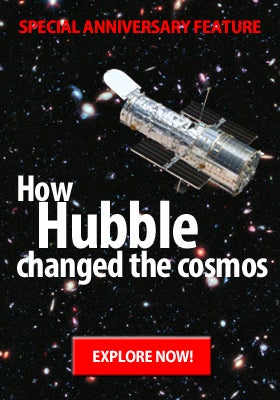A comprehensive analysis of all available Hubble Space Telescope data shows that Nix and Hydra are wobbling unpredictably. Scientists believe the other two moons, Kerberos and Styx, are likely in a similar situation, pending further study.
“Hubble has given us new clues about these mysterious moons as they dance around Pluto,” said John Grunsfeld of NASA’s Science Mission Directorate. “New Horizons’ flyby of Pluto in July will give us a chance to see what they really look like.”
Why the chaos? Because the moons are embedded inside a dynamically shifting gravitational field caused by the system’s two central bodies, Pluto and Charon, whirling about each other. The variable gravitational field induces torques that send the smaller moons tumbling in unpredictable ways. This torque is strengthened by the fact that the moons are football shaped rather than spherical.
“Prior to the Hubble observations, nobody appreciated the intricate dynamics of the Pluto system,” said Mark Showalter of the SETI Institute in Mountain View, California. “Our report provides important new constraints on the sequence of events that led to the formation of the system.”
Hubble provides observational evidence that the satellites are also orbiting chaotically. “However, that does not necessarily mean that the system is on the brink of flying apart,” Showalter said. “We need to know a lot more about the system before we can determine its long-term fate.”
To the surprise of astronomers, Hubble also found that the moon Kerberos is as dark as a charcoal briquette, while the other satellites are as bright as white sand. It was predicted that pollution by dust blasted off the satellites by meteorite impacts should overcoat all the moons, giving their surfaces a homogeneous look. “This is a very provocative result,” Showalter said.
NASA’s New Horizons probe, which will fly by the Pluto-Charon system in July 2015, may help settle the question of the asphalt-black moon as well as the other oddities uncovered by Hubble. These new discoveries are being used in the science planning for the New Horizons’ observations.
The chaos in the Pluto-Charon system offers insights into how planets orbiting a double star might behave. “We are learning that chaos may be a common trait of binary systems,” Hamilton said. “It might even have consequences for life on planets in such systems.” NASA’s Kepler space observatory has found several planetary systems orbiting double stars.
Virtually all large moons, as well as small moons in close-in orbits, keep one hemisphere facing their parent planet. This means that the satellite’s rotation is perfectly matched to the orbital period. This is not coincidental but the consequence of gravitational tides between moon and planet. (Hyperion, which orbits Saturn, is the only other solar system example of chaotic rotation; it is due to the combined gravitational tugs of the planet and its largest moon, Titan).
Pluto’s moons are hypothesized to have formed by a collision between the dwarf planet and another similar-sized body early in the history of the solar system. The smashup flung material that coalesced into the family of satellites observed around Pluto today. Its large binary companion, Charon, was discovered in 1978. The object is almost half the size of Pluto. Hubble discovered Nix and Hydra in 2005, Kerberos in 2011, and Styx in 2012. These little moons, measuring just tens of miles across, were found as part of a Hubble search for potential hazards to the New Horizons spacecraft flyby.
Pluto and Charon are called a double planet because they orbit about a common center of gravity that is located in the space between the bodies. Some regard the Earth-moon system as a double planet, too, although the center of gravity falls beneath Earth’s surface. (Our Moon has 1/80th of Earth’s mass, whereas Charon has 1/8th of Pluto’s mass.)
Researchers say that a combination of monitoring data from Hubble, New Horizons’s brief close-up look, and eventually observations with the James Webb Space Telescope will help settle many mysteries of the Pluto-Charon system. No ground-based telescopes have yet been able to detect the smallest moons.
“Pluto will continue to surprise us when New Horizons flies past it in July,” Showalter said. “Our work with the Hubble telescope just gives us a foretaste of what’s in store.”












